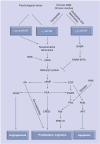Neurotransmitter receptors as central regulators of pancreatic cancer
- PMID: 20146581
- PMCID: PMC2832917
- DOI: 10.2217/fon.09.171
Neurotransmitter receptors as central regulators of pancreatic cancer
Abstract
Pancreatic ductal adenocarcinoma (PDAC) has a near 100% mortality because it is generally detected at an advanced stage and responds poorly to existing therapeutics. This review summarizes current evidence suggesting important roles of neurotransmitter receptors in the regulation of this malignancy. Experimental evidence indicates that the alpha(7)-nicotinic acetylcholine receptor (alpha(7)nAChR) stimulates PDAC via stress neurotransmitter-mediated activation of beta-adrenergic signaling while the alpha(4)beta(2)nAChR inhibits PDAC via GABA-mediated inhibition of adenylyl cyclase activation. In analogy to molecular mechanisms that govern nicotine addiction, chronic exposure to nicotine or its nitrosated derivative nitrosamine 4-(methylnitrosamino)-1-(3-pyridyl)-1-butanone render the stimulatory alpha(7)nAChR hyperactive while desensitizing the inhibitory alpha(4)beta(2)nAChR. Accordingly, PDAC intervention strategies should include the diagnosis of unphysiological neurotransmitter levels and aim to restore any imbalance in stimulatory and inhibitory neurotransmitters.
Figures



Similar articles
-
Nicotinic receptor-associated modulation of stimulatory and inhibitory neurotransmitters in NNK-induced adenocarcinoma of the lungs and pancreas.J Pathol. 2009 Aug;218(4):437-45. doi: 10.1002/path.2542. J Pathol. 2009. PMID: 19274673 Free PMC article.
-
Nicotine stimulates pancreatic cancer xenografts by systemic increase in stress neurotransmitters and suppression of the inhibitory neurotransmitter gamma-aminobutyric acid.Carcinogenesis. 2009 Mar;30(3):506-11. doi: 10.1093/carcin/bgp010. Epub 2009 Jan 8. Carcinogenesis. 2009. PMID: 19131543 Free PMC article.
-
Effects of chronic nicotine on the autocrine regulation of pancreatic cancer cells and pancreatic duct epithelial cells by stimulatory and inhibitory neurotransmitters.Carcinogenesis. 2012 Sep;33(9):1745-53. doi: 10.1093/carcin/bgs229. Epub 2012 Jul 12. Carcinogenesis. 2012. PMID: 22791813 Free PMC article.
-
Molecular pathogenesis of pancreatic ductal adenocarcinoma and clinical implications.Surg Oncol. 2001 Jul-Aug;10(1-2):1-23. doi: 10.1016/s0960-7404(01)00016-0. Surg Oncol. 2001. PMID: 11719025 Review.
-
Neurotransmitter receptor-mediated signaling pathways as modulators of carcinogenesis.Prog Exp Tumor Res. 2007;39:45-63. doi: 10.1159/000100045. Prog Exp Tumor Res. 2007. PMID: 17314500 Review.
Cited by
-
GABAA receptor agonist suppresses pediatric medulloblastoma progression by inhibiting PKA-Gli1 signaling axis.Mol Ther. 2022 Jul 6;30(7):2584-2602. doi: 10.1016/j.ymthe.2022.03.012. Epub 2022 Mar 21. Mol Ther. 2022. PMID: 35331907 Free PMC article.
-
Down-regulation of 5-HT1B and 5-HT1D receptors inhibits proliferation, clonogenicity and invasion of human pancreatic cancer cells.PLoS One. 2014 Aug 29;9(8):e105245. doi: 10.1371/journal.pone.0105245. eCollection 2014. PLoS One. 2014. PMID: 25170871 Free PMC article.
-
Role of the nervous system in cancer metastasis.Oncol Lett. 2013 Apr;5(4):1101-1111. doi: 10.3892/ol.2013.1168. Epub 2013 Jan 31. Oncol Lett. 2013. PMID: 23599747 Free PMC article.
-
Adrenergic receptor β2 activation by stress promotes breast cancer progression through macrophages M2 polarization in tumor microenvironment.BMB Rep. 2015 May;48(5):295-300. doi: 10.5483/bmbrep.2015.48.5.008. BMB Rep. 2015. PMID: 25748171 Free PMC article.
-
Expression pattern and clinical significance of beta 2-adrenergic receptor in oral squamous cell carcinoma: an emerging prognostic indicator and future therapeutic target.Clin Transl Oncol. 2022 Nov;24(11):2191-2199. doi: 10.1007/s12094-022-02879-8. Epub 2022 Aug 2. Clin Transl Oncol. 2022. PMID: 35918593
References
-
- Nieto J, Grossbard ML, Kozuch P. Metastatic pancreatic cancer 2008: is the glass less empty? Oncologist. 2008;13:562–576. - PubMed
-
- ACS. Cancer Statistics 2009. American Cancer Society; 2009.
-
- Lowenfels AB, Maisonneuve P. Risk factors for pancreatic cancer. J Cell Biochem. 2005;95:649–656. - PubMed
-
- Silverman DT. Risk factors for pancreatic cancer: a case–control study based on direct interviews. Teratog Carcinog Mutagen. 2001;21:7–25. - PubMed
-
- Greer JB, Whitcomb DC. Inflammation and pancreatic cancer: an evidence-based review. Curr Opin Pharmacol. 2009;9(4):411–418. - PubMed
Publication types
MeSH terms
Substances
Grants and funding
LinkOut - more resources
Full Text Sources
Medical
